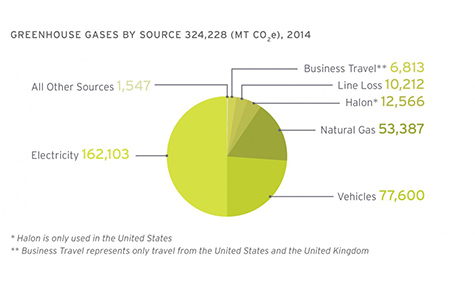Iron Mountain makes public greenhouse gas emissions disclosure to CDP
Learn here how Iron Mountain's operations are being affected by Climate Change, internally and externally. And how we're planning for the future.

How Carbon measurement and reporting are driving business decisions
With the US administration's announcement of new EPA carbon pollution rules and the build-up to the United Nations Conference on Climate Change (COP21) in Paris this December, there is a lot of news these days about Greenhouse Gas (GHG) emissions and climate disruption. It can be hard to separate the important information from the politics in North America, but with real changes in climate becoming increasingly apparent, the key question for a global company like Iron Mountain is; how does this affect our business?
From more severe storms or droughts disrupting business operations or supply chains to the value of real estate as flood zones move, the effects of a changing climate are real, far reaching and very frequently difficult to predict. And the impacts on people are even more difficult to guess. What are the consequences if 100 million Bangladeshis are forced to leave their homes? The first businesses to realize that something was going on were the reinsurance companies like Swiss-RE who saw the risks for increased claims. Then institutional investors started to worry that companies in their portfolio had risks that they didn't know about because business leaders didn't have a way to measure, analyze or share their contributions to the problem or their exposure to the issues. In response to this blind spot, the London based Carbon Disclosure Project (now called CDP) was formed in 2000 with the goal of convincing large companies to measure and report their GHG emissions, risks and actions. Today 1000s of companies report and CDP counts 822 institutional investors with US$95 trillion under management who use this information.
But how can counting carbon deliver a value to our business? Just like in driving, blind spots in business are dangerous. By learning and measuring all the ways our operations create direct and indirect GHG emissions we see our business differently and more information often leads to better decisions. For example in general people think that the new carbon rules will impact energy costs, some say up and some say down which is not very helpful. Because of our new understanding of GHG impacts, we know our carbon emissions from energy by location and can use that information to predict where costs are likely to be most volatile in the future. And we're already taking action such as signing deals for on-site solar power and considering long term fixed price renewable energy contracts which will help us avoid risks. Blind spots can also hid opportunities. For example addressing the carbon intensity of the energy we use for data centers helps us see how to solve a problem for our customers. What if they could reduce their GHG footprint by using our services? These are just a couple of examples of how understanding our environmental impact can quickly translate to financial results for the company.
By measuring and publically sharing our environmental and social impacts through our annual CR Report and with our disclosure to CDP we not only satisfy the demands of customers, investors and stakeholders for transparency and accountability, we can add new information to business decisions of all kinds. This is new for us and we're still learning, but so far it's been amazing to see employees from different parts of the business discover how new information can help them make more informed decisions. We're looking forward to expanding our reach to more territories of the business and sharing this new approach with more employees.
Related resources
View More Resources
How to Safely Operationalise AI: From Hype to Enterprise Value

Making Data AI-Ready: How Leading Organisations Are Building Smarter and Safer Ecosystems
 Premium
Premium